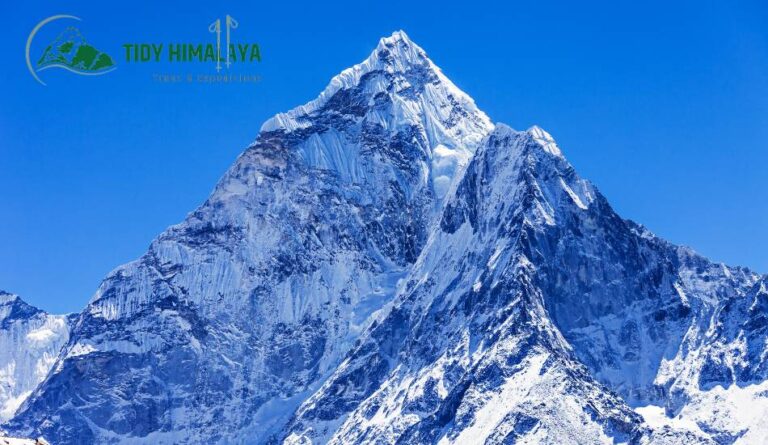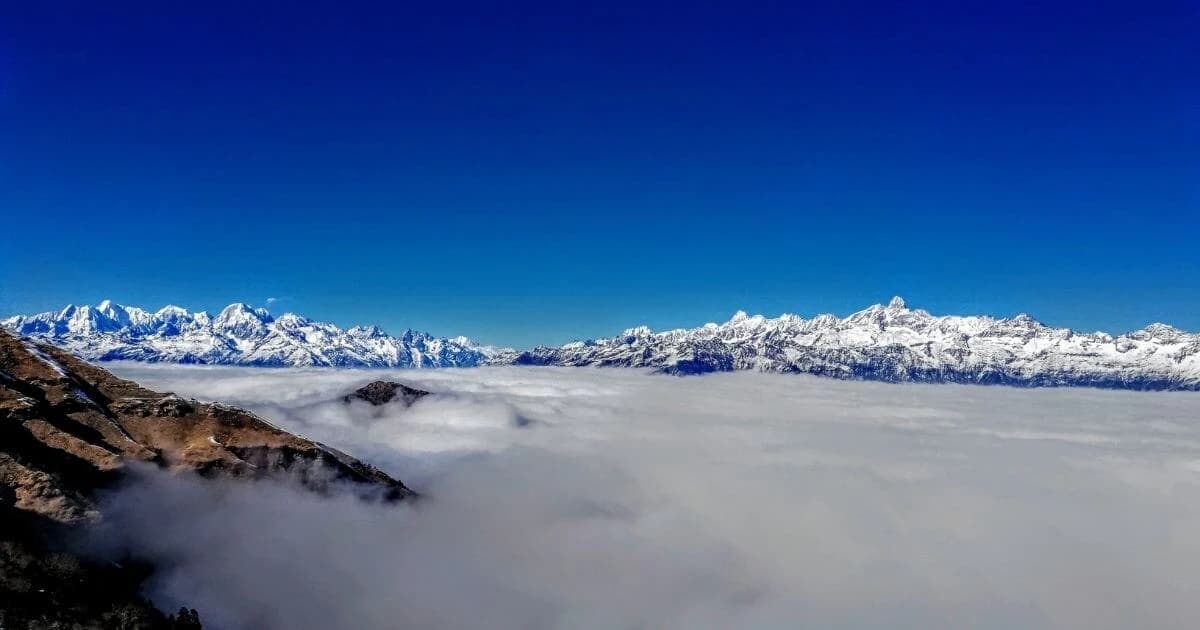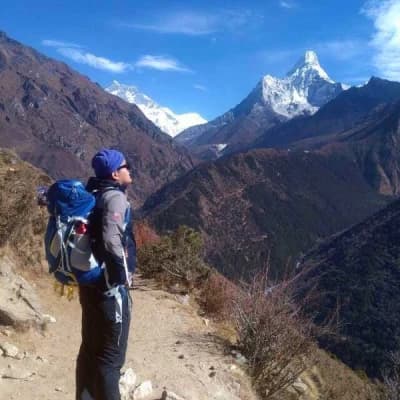Mount Everest, at 8,848 meters, is the tallest and listed as one of the highest mountains in the world and is located in Nepal’s Himalayas. You probably already knew that. When one asks 100 individuals worldwide to name a mountain, most will respond with Mount Everest. Fewer people are aware that Kangchenjunga is the third-highest peak in the world. The majority of people are aware that the second-highest peak in the world is K2, which is situated near the Pakistan-China border. Or the proper way to spell that. Indeed, it is not relatively as easy as “K2.” So, how many of the world’s highest mountains are you actually aware of?
Although Everest usually gets all the attention, Asia as a whole is home to other massive mountains. Asia is home to all 100 of the world’s tallest mountains. With the exception of Everest, none of the seven summits—the highest peaks on each continent—are included on this list. Finding someone aware of the world’s sixth, seventh, or eighth-highest mountains is relatively uncommon.
So, let us get started. Let us help you become familiar with the world’s seven tallest mountains. Let us help you use the sketchy Wi-Fi and your phone under the table to cheat on this pub quiz you are most likely taking right now. I feel not guilty. It is practiced by all. In the music round, the team with the dog was undoubtedly cheating. The planet’s top 7 highest mountains are listed below, in order of height:
Overview of the 7 Highest Mountains in the World
| S.No. | Mountain Name | Elevation (ft) |
Elevation (m) | Himalayan Range/Section | World Rank | Nepal Rank |
| 1 | Mount Everest | 29,032 | 8,848.86 | Khumbu Mahalangur | 1 | 1 |
| 2 | K2 | 28,251 | 8,611 | Karakoram Range | 2 | |
| 3 | Kanchenjunga | 28,169 |
8,586 |
Northern Kanchenjunga | 3 | 2 |
| 4 | Lhotse | 27,940 | 8,516 | Everest Group | 4 | 3 |
| 5 | Makalu | 27,824 | 8,481 | Makalu Mahalangur | 5 | 4 |
| 6 | Cho Oyu | 26,864 | 8,188 | Khumbu Mahalangur | 6 | 5 |
| 7 | Dhaulagiri | 26,795 | 8,167 | Dhaulagiri | 7 | 6 |
Here are the top 7 highest mountains in the world, ranked in ascending order of elevation.
Mount Everest: At an elevation of 8,848.86 meters (29,032 feet), Mount Everest is situated in the Khumbu Mahalangur range. It is ranked first in Nepal and the world.
K2: At an elevation of 8,611 meters (28,251 feet), K2 is situated in the Karakoram range. It is ranked second in the entire world.
Kanchenjunga: Situated in the Northern Kanchenjunga range at an elevation of 8,586 meters (28,169 feet). It is ranked second in Nepal and third in the entire world.
Lhotse: Elevation 8,516 m (27,940 ft), Lhotse is a member of the Everest Group. It is ranked third in Nepal and fourth in the entire world.
Makalu: Situated in the Makalu Mahalangur range at an elevation of 8,481 meters (27,824 feet). It is ranked fourth in Nepal and fifth in the entire world.
Cho Oyu: Situated in the Khumbu Mahalangur range at an 8,188 meters (26,864 feet) elevation. It is ranked fifth in Nepal and sixth in the entire world.
Dhaulagiri: Situated in the Dhaulagiri range at an elevation of 8,167 meters (26,795 feet). It is ranked sixth in Nepal and seventh in the entire world.
Mount Everest (8,848.86 meters)

Elevation/Height: 8,848 meters
Location: China's Tibet Autonomous Region, Nepal/Himalayas
Of course, Mount Everest is the tallest mountain in the world, having been ascended for the first time by Tenzing Norgay and Sir Edmund Hillary in 1953. Everest has recently become the subject of intense attention. Images displaying massive lines near the top have sparked a heated discussion about Everest congestion. But one thing is sure—the allure that Mount Everest has always had will never fade. Similar to moths to a flame, humanity is drawn to the mountain. Trekking to the Everest Base Camp is very popular, as is the route leading from the base camp to the summit. Indeed, it has become as one of the most renowned multi-day hikes globally.
Everest Base Camp Trek
Trekkers can experience the breathtaking Everest Base Camp Trek, which takes them to the mountain’s north and south base camps. This hike offers a close-up look at the mountain’s majesty, making it the adventure of a lifetime.
Book Your Everest Base Camp Trek
Learn about How to Train for the Everest Base Camp Trek? and How Hard is the Everest Base Camp Trek?
K2 (Mount Godwin-Austen) (8,611 meters)

Elevation/Height: 8,611 meters
Location: Pakistan/China
K2 is the second-highest mountain on Earth. The Great Trigonometrical Survey of British India’s notation gave rise to the mountain’s name, which stayed since there was no prominent local name at the time. K2 is also known as the “Savage Mountain,” which is excellent in an over-the-top, extreme, Point Break kind of way. That is also appropriate, though.
Despite being the second-tallest peak in the world, the mountain is regarded as one of the hardest in the world to climb, with a reputation for being more difficult than Mount Everest. With almost 300 successful summits and 77 deaths, K2 actually has the 2nd-highest fatality rate per summit attempt of all the mountains over 8000 meters. The 10th-highest peak in the world, Annapurna I in Nepal, has the most significant death rate (spoiler alert). However, until this winter, K2 has never been summited in the winter, in contrast to Annapurna.
Kanchenjunga (8,586 meters)

Elevation/Height: 8,586 meters
Location: Nepal/India, The Himalayas
You were aware that Mount Everest was the world’s highest mountain. You were even aware that K2 was the runner-up. However, most people would assume that Kangchenjunga was a type of street cuisine if you asked them what it was. It is not. The third-highest peak in the world is called Kangchenjunga. Three peaks are located on the boundary between Nepal and Sikkim, India, and the remaining two are in Nepal’s Taplejung District.
As a result, Kangchenjunga is now at its highest peak in India. Up until 1852, the mountain was indeed believed to be the highest peak in the globe. This was due to incorrect estimations made by the individuals, not a lack of knowledge about Mount Everest. When additional research by the Great Trigonometrical Survey of India revealed that Kangchenjunga was actually the third-highest mountain in the world, kids everywhere sighed with relief that their primary study would instead focus on Mount Everest. This mountain is much simpler to pronounce and spell.
Lhotse (8,516 meters)

Elevation/Height: 8,516 meters
Location: China's Tibet Autonomous Region, Nepal/Himalayas
Lhotse is one of the more well-known mountains on any list of the world’s top 7 highest peaks, mainly because of its proximity to Mount Everest. The ascent of Lhotse follows the same path as Mount Everest from Everest Base Camp, passing Camp 3 and going up the Lhotse Face to the Reiss couloir, which goes all the way to the summit of Lhotse.
Lhotse resembles Mount Everest’s neglected younger sibling. Although Lhotse is frequently regarded as more aesthetically pleasing, Everest receives all the attention, whereas Lhotse is far less busy. Although Lhotse’s main summit was initially reached in 1956, the Lhotse Middle held the title of the highest unclimbed named point on Earth for many years. Finally, a Russian expedition ascended it for the first time in 2011.
Makalu (8,481 meters)

Elevation/Height: 8,485 meters
Location: China's Tibet Autonomous Region, Nepal/Himalayas
The third of Nepal’s four 8,000-meter-high mountains is Makalu, located in the Everest Massif. In 1955, Jean Franco led a French team that made the first ascent of the peak. The fact that all ten expedition team members reached the mountain peak during the trip made their ascension particularly noteworthy. This was a significant accomplishment at the time because, in those days, only one or two climbers from each team reached the top of the mountain on an expedition.
Besides, it is generally just really incredible, isn’t it? On May 15, 1955, the first two summits were reached; four more followed the next day and four more the day after that. Really, it is just some very healthy mountain climbing.
Cho Oyu (8,188 meters)

Elevation/Height: 8,188 meters
Location: China's Tibet Autonomous Region, Nepal/Himalayas
Cho Oyu is the fourth and last person in the 8000-meter club in the Everest region. Because of its more moderate ascent, Cho Oyu, the sixth-highest mountain in the world at 8188 meters, is regarded as the simplest of the 8000-meter peaks to scale. Additionally, the Nangpa La Pass, a vital commercial route between the Khumbu Sherpas and Tibetan, is only a few kilometers away. If the four 8000-meter-plus mountains in the Everest region were a boyband, Cho Oyu would be the cool, collected backup vocalist. The most relatable, perhaps, but hardly the most showy.
The mountain of humanity. In case you were wondering, Lhotse would make the ideal vocalist because Everest’s outrageous hairstyles constantly steal the show, while Makalu would be in the background, ensuring that everyone got along—strange comparison. We are aware. Let us proceed quickly.
Dhaulagiri (8,167 meters)

Elevation/Height: 8,167 meters
Location: Nepal
At 8167 meters, the Dhaulagiri Mountain in Nepal is the seventh-highest peak in the world and one of the most beautiful mountains in terms of scenery. First climbed on May 13, 1960, the Dhaulagiri is most recognized for its visibility on the well-traveled Annapurna Circuit, where Annapurna I is only 34 km distant. The Dhaulagiri is a common sight on the skyline while trekking Annapurna.
It is not a region that lacks scenery, as the mountains are divided by the Kaligandaki Gorge, the deepest gorge in the world.
Climbing the 7 Highest Mountains
“Climbing the 7 Highest Mountains” emphasizes the incredible mental and physical obstacles that climbers must overcome to reach the 7 Summits, the highest peaks on each continent. In addition to dealing with unpredictable weather and particular technical challenges like crevasses and icefalls, climbers must withstand severe elevations, running the danger of altitude sickness and oxygen depletion. Specialized high-altitude footwear, harnesses, ropes, ice axes, crampons, and insulated clothing are all necessary pieces of equipment. In order to succeed, climbers must undergo extensive physical training and acclimatization, which guarantees they are ready for the challenging circumstances and low oxygen levels at high altitudes.
Physical and Mental Challenges
The Seven Summits, or the seven highest peaks on each continent, are reached only by those with extraordinary physical and mental fortitude. Climbers must endure extreme heights, which increases the risk of altitude sickness and oxygen deficiency. Unpredictable weather, including strong winds, intense cold, and unexpected storms, adds a further element of hardship.
Furthermore, climbers must be extremely talented and adaptive because every mountain has its own unique set of technical difficulties, like crevasses, steep ascents, and dangerous icefalls.
Necessary Gear and Preparation
Climbing these summits successfully requires specific equipment and careful planning. High-altitude footwear, harnesses, ropes for safety in crevassed areas and steep climbs, ice axes for climbing and self-arrest, crampons for ice and snow traction, and other essential equipment are all necessary. It is vital to wear specialized apparel made for frigid and high-altitude temperatures, such as helmets, gloves, insulated jackets, and pants.
Thorough physical training is necessary for preparation in order to increase cardiovascular fitness, strength, and endurance. In order to adjust to the reduced oxygen levels at high altitudes, climbers must also go through acclimatization phases. Typically, they spend time at intermediate elevations and perform practice climbs before attempting to reach the summit.
Summing Up
The seven highest mountains in the world represent the pinnacle of natural beauty and human endurance. Climbing these peaks requires immense preparation, skill, and determination. This guide provides comprehensive insights into each mountain, helping enthusiasts appreciate their unique challenges and significance.
In conclusion, Nepal’s mountains are indeed impressive. Though Mount Everest is a star, this Himalayas region is home to many more amazing peaks. The sixth tallest mountain in the world is found in Nepal; we have already visited the top seven. Every hill has an intriguing backstory where the majesty of nature collides with the bravery and curiosity of people. It is an experience that perfectly encapsulates the Himalayas.
FAQs
What are the main risks of high-altitude climbing?
Acute mountain sickness, high-altitude cerebral edema, high-altitude pulmonary edema, extreme weather, avalanches, crevasses, and falls are only a few of the serious concerns associated with high-altitude climbing. Because of these risks, climbing to high altitudes is quite risky and can cause fatalities or severe injuries.
What's the significance of the "8000-meter club" in mountaineering?
The “8000-meter club” refers to mountaineers who have successfully summited one or more of the 14 peaks worldwide that exceed 8,000 meters (26,247 feet) in height. These peaks are considered the most challenging and dangerous to climb, and achieving this feat is a prestigious accomplishment in the mountaineering community, symbolizing exceptional skill, endurance, and bravery.
Is Mount Everest the most dangerous of the 8,000-meter peaks?
Though it is the tallest and most famous of the 8,000-meter peaks, Mount Everest is not always the most hazardous. Mountains with more demanding routes, erratic weather, and technical challenges, such as Annapurna and K2, have more excellent fatality rates. Even climbing Everest is still dangerous due to its high altitude and widespread appeal.
What is the best time of year for trekking and climbing in Nepal's mountains?
The best time for climbing and trekking in Nepal is during the pre-monsoon (spring) and post-monsoon (autumn) seasons. Spring (April to early June) offers warmer weather and blooming rhododendrons, while autumn (late September to November) provides clearer skies and stable weather conditions, ideal for climbing.
Are there any age restrictions for climbing the highest mountains?
Region-specific and mountain-specific legislation determines the age limits for climbing high mountains. Climbers on Mount Everest, for instance, need to be at least 16 years old. Older or younger climbers may require specific authorization or face extra scrutiny; age alone is not a significant issue. Extra important considerations include physical fitness, experience, and general health.
What is the significance of the "Death Zone" on these famous mountains?
Altitudes exceeding 8,000 meters (26,247 feet), where there is not enough oxygen to support human life for prolonged periods of time, are referred to as the “Death Zone.” Climbers who venture into this zone run the severe risk of experiencing hypoxia, rapid physical and mental decline, and heightened susceptibility to weather variations. Swift ascents and descents, extra oxygen, and careful planning are essential for survival.
Which mountain is the hardest to climb?
The second-highest peak in the world, K2, is thought to be the most difficult to climb because of its high death rate, extreme weather, and technical complexity. It is one of the most challenging and hazardous summits for mountaineers because of its exposed, steep slopes and frequent avalanches.


.webp&w=1200&q=75&dpl=dpl_2PwU5ZDv8uoJ3KrzEVbz8N547HgX)
.webp&w=1200&q=75&dpl=dpl_2PwU5ZDv8uoJ3KrzEVbz8N547HgX)
.webp&w=1200&q=75&dpl=dpl_2PwU5ZDv8uoJ3KrzEVbz8N547HgX)